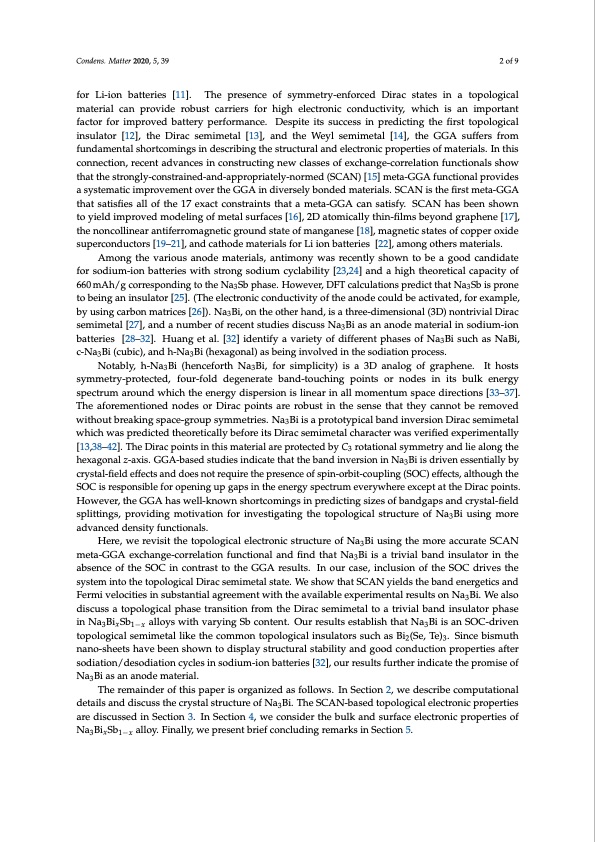
PDF Publication Title:
Text from PDF Page: 002
Condens. Matter 2020, 5, 39 2 of 9 for Li-ion batteries [11]. The presence of symmetry-enforced Dirac states in a topological material can provide robust carriers for high electronic conductivity, which is an important factor for improved battery performance. Despite its success in predicting the first topological insulator [12], the Dirac semimetal [13], and the Weyl semimetal [14], the GGA suffers from fundamental shortcomings in describing the structural and electronic properties of materials. In this connection, recent advances in constructing new classes of exchange-correlation functionals show that the strongly-constrained-and-appropriately-normed (SCAN) [15] meta-GGA functional provides a systematic improvement over the GGA in diversely bonded materials. SCAN is the first meta-GGA that satisfies all of the 17 exact constraints that a meta-GGA can satisfy. SCAN has been shown to yield improved modeling of metal surfaces [16], 2D atomically thin-films beyond graphene [17], the noncollinear antiferromagnetic ground state of manganese [18], magnetic states of copper oxide superconductors [19–21], and cathode materials for Li ion batteries [22], among others materials. Among the various anode materials, antimony was recently shown to be a good candidate for sodium-ion batteries with strong sodium cyclability [23,24] and a high theoretical capacity of 660 mAh/g corresponding to the Na3Sb phase. However, DFT calculations predict that Na3Sb is prone to being an insulator [25]. (The electronic conductivity of the anode could be activated, for example, by using carbon matrices [26]). Na3Bi, on the other hand, is a three-dimensional (3D) nontrivial Dirac semimetal [27], and a number of recent studies discuss Na3Bi as an anode material in sodium-ion batteries [28–32]. Huang et al. [32] identify a variety of different phases of Na3Bi such as NaBi, c-Na3Bi (cubic), and h-Na3Bi (hexagonal) as being involved in the sodiation process. Notably, h-Na3Bi (henceforth Na3Bi, for simplicity) is a 3D analog of graphene. It hosts symmetry-protected, four-fold degenerate band-touching points or nodes in its bulk energy spectrum around which the energy dispersion is linear in all momentum space directions [33–37]. The aforementioned nodes or Dirac points are robust in the sense that they cannot be removed without breaking space-group symmetries. Na3Bi is a prototypical band inversion Dirac semimetal which was predicted theoretically before its Dirac semimetal character was verified experimentally [13,38–42]. The Dirac points in this material are protected by C3 rotational symmetry and lie along the hexagonal z-axis. GGA-based studies indicate that the band inversion in Na3Bi is driven essentially by crystal-field effects and does not require the presence of spin-orbit-coupling (SOC) effects, although the SOC is responsible for opening up gaps in the energy spectrum everywhere except at the Dirac points. However, the GGA has well-known shortcomings in predicting sizes of bandgaps and crystal-field splittings, providing motivation for investigating the topological structure of Na3Bi using more advanced density functionals. Here, we revisit the topological electronic structure of Na3Bi using the more accurate SCAN meta-GGA exchange-correlation functional and find that Na3Bi is a trivial band insulator in the absence of the SOC in contrast to the GGA results. In our case, inclusion of the SOC drives the system into the topological Dirac semimetal state. We show that SCAN yields the band energetics and Fermi velocities in substantial agreement with the available experimental results on Na3Bi. We also discuss a topological phase transition from the Dirac semimetal to a trivial band insulator phase in Na3BixSb1−x alloys with varying Sb content. Our results establish that Na3Bi is an SOC-driven topological semimetal like the common topological insulators such as Bi2(Se, Te)3. Since bismuth nano-sheets have been shown to display structural stability and good conduction properties after sodiation/desodiation cycles in sodium-ion batteries [32], our results further indicate the promise of Na3Bi as an anode material. The remainder of this paper is organized as follows. In Section 2, we describe computational details and discuss the crystal structure of Na3Bi. The SCAN-based topological electronic properties are discussed in Section 3. In Section 4, we consider the bulk and surface electronic properties of Na3BixSb1−x alloy. Finally, we present brief concluding remarks in Section 5.PDF Image | Topological Dirac Semimetal Phase in Bismuth Based Anode Materials for Sodium-Ion Batteries

PDF Search Title:
Topological Dirac Semimetal Phase in Bismuth Based Anode Materials for Sodium-Ion BatteriesOriginal File Name Searched:
condensedmatter-05-00039-v3.pdfDIY PDF Search: Google It | Yahoo | Bing
Sulfur Deposition on Carbon Nanofibers using Supercritical CO2 Sulfur Deposition on Carbon Nanofibers using Supercritical CO2. Gamma sulfur also known as mother of pearl sulfur and nacreous sulfur... More Info
CO2 Organic Rankine Cycle Experimenter Platform The supercritical CO2 phase change system is both a heat pump and organic rankine cycle which can be used for those purposes and as a supercritical extractor for advanced subcritical and supercritical extraction technology. Uses include producing nanoparticles, precious metal CO2 extraction, lithium battery recycling, and other applications... More Info
| CONTACT TEL: 608-238-6001 Email: greg@infinityturbine.com | RSS | AMP |